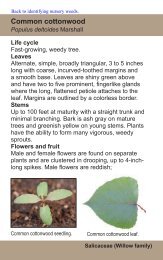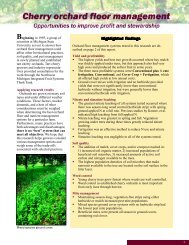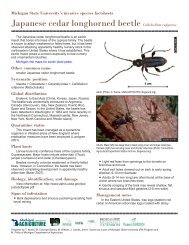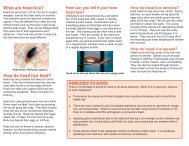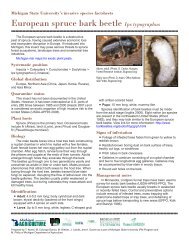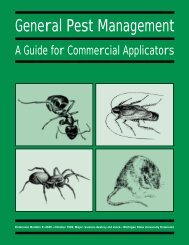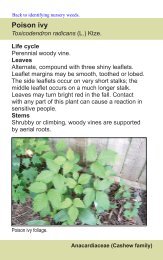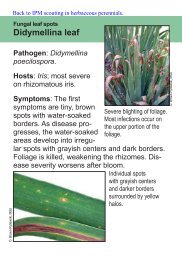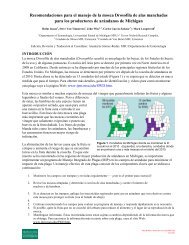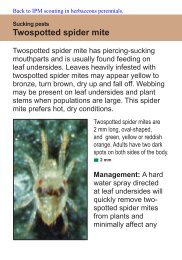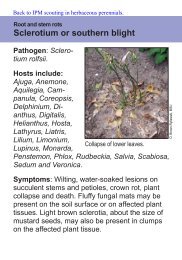Whole Manual - Michigan State University: Integrated Pest ...
Whole Manual - Michigan State University: Integrated Pest ...
Whole Manual - Michigan State University: Integrated Pest ...
Create successful ePaper yourself
Turn your PDF publications into a flip-book with our unique Google optimized e-Paper software.
■ Select the least hazardous pesticide formulation and<br />
lowest toxicity if bees are present. Dusts are more<br />
hazardous to bees than sprays. Wettable powders are<br />
more hazardous than emulsifiable concentrates (EC)<br />
or water-soluble formulations. Microencapsulated<br />
pesticides are extremely dangerous to bees because the<br />
very small capsules can be carried back to the hive.<br />
Granular insecticides are generally the least hazardous<br />
to bees.<br />
■ Do not apply pesticides that are toxic to bees if the<br />
site contains a blooming crop or weed. Remove the<br />
blooms by mowing before spraying.<br />
■ Minimize spray drift by selecting appropriate nozzles,<br />
adding an adjuvant, or postponing the application<br />
to a less windy time.<br />
■ Time pesticide applications carefully. Evening applications<br />
are less hazardous than early morning ones;<br />
both are safer than midday applications.<br />
<strong>Pest</strong>icides can also be harmful to vertebrates such as<br />
fish and wildlife. Fish kills may result when a pesticide<br />
(usually an insecticide) pollutes water or changes the pH<br />
of the water. <strong>Pest</strong>icides may enter water via drift, surface<br />
runoff, soil erosion, or leaching.<br />
POTENTIAL FOR PESTICIDE RESISTANCE<br />
<strong>Pest</strong>icide resistance is a measurement of a pest’s ability<br />
to tolerate the toxic effects of a particular pesticide.<br />
Intensive use of a product may allow only resistant individuals<br />
to survive. As the number of resistant individuals<br />
increases in a pest population, the original application rate<br />
or spray frequency no longer provides adequate control.<br />
The Development of Resistance<br />
Repeated applications of the same pesticide or of pesticides<br />
with a common mode of action give a pest population<br />
a chance to develop resistance. Resistance is an<br />
individual’s (weed, crop, insect, etc.) ability to survive a<br />
specific pesticide application. There are three mechanisms<br />
of resistance. Resistant individuals:<br />
1. May have a modified site of action so that the pesticide<br />
is no longer toxic.<br />
2. Metabolize (detoxify) the pesticide. Metabolism is<br />
a biochemical process that modifies the pesticide to<br />
less toxic compounds.<br />
3. Remove the pesticide from the site of action.<br />
Resistant individuals have the genetic ability to survive<br />
when the pesticide is applied, and their offspring<br />
inherit the pesticide resistance. Because the pesticide kills<br />
most of the non-resistant individuals, the resistant organisms<br />
over time make up an increasingly larger percentage<br />
of the surviving pest population. With each use of the<br />
pesticide, this percentage increases until most of the pests<br />
are resistant and the chemical is no longer effective<br />
against the pest.<br />
<strong>Pest</strong>icides may result in bird kills if birds ingest granules,<br />
baits, or treated seed; are exposed directly to the<br />
spray; drink and use contaminated water; or feed on pesticide-contaminated<br />
prey.<br />
Endangered and threatened species are of special<br />
concern. Under the federal Endangered Species Act,<br />
every pesticide posing a threat to an endangered or<br />
threatened species or to its habitat must have a warning<br />
statement on the label. The warning provides instructions<br />
on how to safeguard the species when using the<br />
pesticide within its habitat.<br />
In most cases, pests that are resistant to one pesticide<br />
will show resistance to chemically related pesticides. This<br />
is called cross-resistance. Cross-resistance occurs because<br />
closely related pesticides kill pests in the same way—for<br />
example, all organophosphate insecticides kill by inhibiting<br />
the same enzyme in the nervous system,<br />
cholinesterase. If a pest can resist the toxic action of one<br />
Chapter 2<br />
12<br />
Vegetable Crop <strong>Pest</strong> Management



